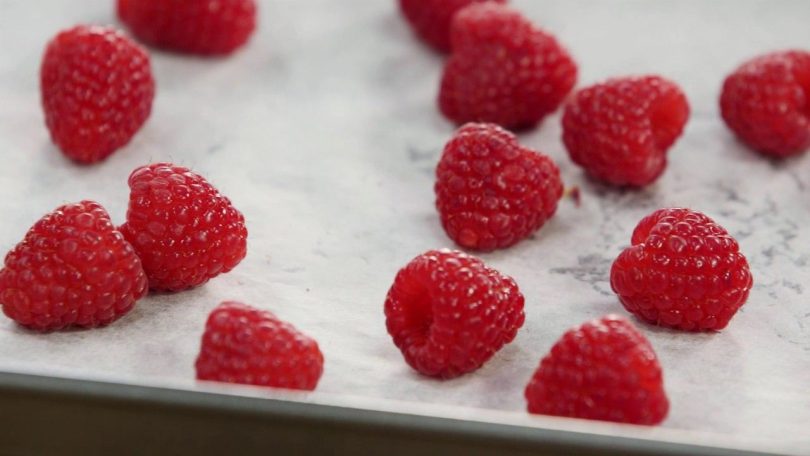Here are the easiest methods of dehydrating raspberries at home.
Dehydrating or drying is one of the most effective ways to preserve food, especially fruits that go bad faster. Almost as always, you’ll have to consume them within 24 hours of purchase or you won’t be able to enjoy your favorite fruits, like raspberries. It is easy to dehydrate raspberries, the following guide will be helpful.
SEE ALSO: How to Dehydrate Food Successfully: A Beginner’s Guide
How to Dehydrate Raspberries
Dehydrating raspberries in a dehydrator
Choose raspberries that are not overripe. They will not dehydrate well and might fall apart if they are overripe and mushy. Look for the firm to the touch. They should be bright red, not dark burgundy (it means the raspberries are super ripe).
- Put the raspberries in a strainer and wash them thoroughly.
- Once you’ve finished washing, arrange the raspberries in a single layer on paper towels or cloth. Gently blot them out to remove excess water. Dry them out the best you can. They are likely to absorb twice their weight in water, hence, it’s hard to completely dry them. Take note that raspberries have a small hole in the center that holds water as well. If they are not completely dry, it will take a long time to dehydrate them.
- To speed up the dehydration process, you can slice the raspberries in half (you may do it vertically), using a knife. Whole berries take longer to dehydrate.
- Arrange the raspberries on your dehydrator trays. Make sure to keep every berry plenty of room to allow better air circulation. Put them upside down so that the water in the hole will be drained out.
- Spray them lightly with lemon juice so they don’t turn brown. You shouldn’t worry about tasting the lemon juice because once the raspberries are dehydrated, they won’t taste like lemon.
- Put your trays inside the dehydrator. Set temperature at 133 to 140°F.
- Dehydrate them in the food dehydrator for 10 to 12 hours. When it reaches the 10th hour, check the fruits every hour or so.
The raspberries are dried out completely if you can’t feel any softness or moisture on the berries at all. The raspberries will be light and crispy when fully dehydrated. They will be crunchy if you take a bite.
SEE ALSO: A Guide for Beginners: How to Dehydrate Food with a Dehydrator
Dehydrating raspberries in the oven
Oven-dried raspberries would be perfect for baking, cereals, trail mixes, and granola. You can grind them to make raspberry powder and use it if you want to get authentic raspberry flavor and color when making your cake frosting.
Here are the steps to follow to successfully dehydrate raspberries in the oven:
- Using a strainer, wash the raspberries.
- Put them on paper towels or cloth and dry them out.
- Line a baking sheet with parchment paper.
- Arrange the raspberries on the parchment paper. Making sure there is enough space between the berries to allow for warm air to circulate.
- Turn the temperature into the lowest setting. (Recommended: 150°F.) You can leave the oven door slightly open for better air circulation.
- After 6 hours inside the oven, the berries would have been dried out. You’ll get soft and pliable raspberries at the end of the 6th hour. If you want them crispy, dry the raspberries in the oven for 8 hours instead of 6 hours.
You have to check on the raspberries towards the end of the baking time so you can test them for doneness.
How to Store Dried Raspberries
The dehydrated raspberries should be completely cool to the touch before packaging. The air that surrounds the warm dried raspberries will hold more moisture content, and eventually will be released when the berries cool down. If you pack the berries without completely cooling them down, moisture will form inside the container thereby reducing the shelf life of the dehydrated raspberries.
Your dried raspberries should be conditioned before putting in storage containers. Place the dried berries loosely in a clean jar. Keep them there between 7 to 10 days. Shake the jar at least once a day. If during the conditioning stage, you notice condensation in any of the jar, repeat the process of dehydrating the berries for further drying.
The dehydrated raspberries should be stored in air-tight containers or freezer bags. You may use a jar that features an airtight seal. If you opt to use plastic bags for storage, make sure you use the freezer bags. These freezer bags are thicker compared to your regular sandwich bags.
If you are using freezer bags to store the dried raspberries, it is important to remove air from the bag before sealing.
Vacuum-sealing helps extend the shelf life of your dried raspberries as it effectively and easily removes air, thereby preventing moisture and development of molds.
Some people use sulfur when washing raspberries. Store these sulfured raspberries in non-metal jars or containers. You may also put them in a plastic bag before finally placing them in the metal container. If this is not done, sulfur will react to the metal which may create off-flavors.
Store dried raspberries in small batches as this helps maintain their freshness. It also minimizes the risk of contamination. With having separate batches, you avoid opening and closing the container whenever you need them. Doing so will only create a moisture which can lead to early spoilage and the growth of molds.
Make sure to label each of the containers with the date the product or products were processed and packed. This technique identifies the items that need to be consumed first.
Store the containers with dried raspberries in a cool, dark, and dry location. The ideal temperature is 60°F or less. Exposure to light will degrade the dried raspberries.
Store them inside the freezer. This will extend the shelf life of the berries. Dried raspberries can be stored for up to one year. If you notice moisture in the containers, you will have to repeat the process of dehydrating raspberries.
Place the older items (first batches) in front of the freezer so you can use them first to avoid spoilage.
SEE ALSO: How to Store Dried Fruits at Home
Dehydrating or drying of fruits is a great way of preserving your favorite fruits. You can use them when cooking your favorite recipes. Some eat them as snacks. You can also add them to your breakfast cereals. If the process of dehydrating raspberries is done right, they can last up to a





